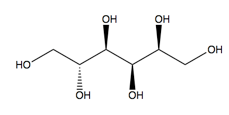Sorbitol
Natural sugar alcohol, a product of glucose reduction:
 Sorbitol
Sorbitol
It is naturally found in many berries and fruits, e.g., apples, rowanberries, dried plums, cherries, and grapes. Industrially produced from glucose. Sorbitol is a food additive (index E420), used as a stabilizer, low-calorie sweetener, emulsifier.
The body receives sorbitol not only through food, but human cells produce it themselves. When cells accumulate too much sorbitol internally, it acts toxically. Diabetic retinopathy and neuropathy may be related to excess sorbitol in eye or nerve cells. Sorbitol in diabetic bodies is formed from excess glucose, processed through the sorbitol dehydrogenase reduction pathway. It removes water and salts from the body, not fats. This is very risky. Large amounts of sorbitol can cause abdominal pain, bloating, and diarrhea (from mild to severe). An excessive dose can worsen fructose absorption. Not recommended for infants under 1 year old.
Sorbitol helps the body absorb less of vitamins B1 and B6, biotin, improves intestinal microflora. When using this substitute, the stomach secretes more juices, gallbladder activity is activated. It acts slightly laxative, so it can be used for constipation. However, consuming more than 30 g of this sweetener at once may cause stomach discomfort, nausea, bloating. It is believed to promote gallstone formation. The safe dose is up to 50 g per day.
Sorbitol destroys oral bacteria, thus reducing the risk of tooth decay.
Source | Glossary of Most Commonly Used Biomedical Terms and Concepts | Lithuanian University of Health Sciences | Academician Professor Antanas Praškevičius, Professor Laima Ivanovienė
